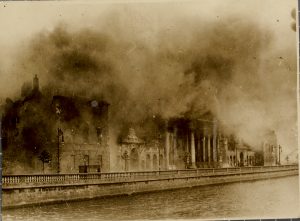Last week, RTÉ TV news ran a piece of techno-utopianism that really got my attention. A group based in Trinity College are going to create a digital 3-D model of the old Public Record Office that was destroyed in 1922.

Fair enough. The centenary of that ignominious act is approaching and it certainly needs remembering.
Then the report went on to say that the group was also going to digitally reconstruct the records that had been destroyed, thus retrieving seven lost centuries of history and genealogy. Say again? They’re going to magic back into existence the ten million or so returns from the lost censuses of 1821, 1831, 1841 and 1851? How? By closing their eyes and clicking their heels together three times?
The group’s website tells a more nuanced story. Yes, there will indeed be a shiny, walk-through digital model, but the approach to reconstructing records is modest enough. It centres on using Herbert Wood’s A Guide to the Records Deposited in the Public Record Office of Ireland (Dublin, 1919) to identify substitutes for what was destroyed, much as the National Archives of Ireland has been doing since 1922 with, for example, its testamentary record substitutes. The difference is that copies of, or links to, the substitute material will be organised within the virtual model, thus recreating (kind of) the experience of using the old PRO.
It’s a good idea. Any opportunity to digitise and publicise surviving fragments and substitutes is very welcome. And it should also shine a light into a few areas that don’t get enough attention – the seven volumes of thirteenth to sixteenth-century excerpts from plea rolls, patent rolls and pipe rolls in the National Library Genealogical Office collection (GO 189-95), for one.
But I think that the end result is likely to be more dystopian than utopian. At last we’ll get to see, perfectly-rendered, the size and shape of the black hole at the heart of Irish history and genealogy.
The project site has a news page that links to all the attention they got last week. It wasn’t just RTE, nearly every other news outlet got the story wrong and reported the imminent return out of digital thin air of all the lost records. The team need to be a bit more careful about how they attract attention to what they’re doing. Some of those news reports look distinctly fake.
Hi John, I heard this plan on the radio but guessed it was an impossible task, they should have clarified what was possible and impossible for this project. Maybe apart from the sources you included above this project will include all other available sources and transcripts for example Canon William Carrigan’s transcripts of 19th century census records, wills and other records he copied over his lifetime. I mentioned him before but there must be others like him who transcribed records that could be ferreted out and added in time.
I am looking forward to seeing what it looks like all the same.
Regards
David
Oh no, not Fake News!
You said it so well and confirmed what I was thinking when I read the news report. Thank you for clarifying that is not senility that made me wonder what ??? I am waiting for my small time machine just to drop me back where I can meet my great-grandfather and figure out who he married, and whatever happened to any siblings of my grandfather. So simple and yet… Where is Dr Who when you need him??
The news report left out the part about how they are devising a plan to drop a patriot into the time tunnel to figure out a way to break in and fetch the records. John, you would be perfect for this!
I was amazed at the coverage, all seemingly believing long-gone records would magically reappear. Reading more closely, my take was that it will just be a portal linking to everything already online, but not digitizing anything new. The only “new” aspect I saw was the involvement of TNA, so some records of interest that some genealogists / historians might overlook because the records are in England, would be brought to the attention of researchers. Here’s hoping you’re right and there will be new materials digitized…
Thank you for this. I got my hopes wildly up, but knew in my heart I was being irrational, and couldn’t believe they would promise such a thing. They seem very delighted and hopeful… but I have to keep saying, “Joy, you know better…. you know better… it’s good enough just to know your great great grandparents…” and, it kind of is, isn’t it?
I wish to God that Trump or whomever never invented the phrase “Fake News.” What we have called this “over-promise” before that phrase?
What would we – is what I meant.
Completely agree, I read the full article and replied to one of my little genie group mates that as it read the task was impossible. I felt (hoped) they may link online images to all that other depositories had eg PRONI, local history groups etc etc to make substitutes and it might turn out to all be in the one place which would be handly. Thanks for the blog, I always enjoy them.
I think the boffins from Trinity should work on an additional 3-D feature allowing visitors to the site to kick the virtual arses of the leaders of the belligerents from both sides, Rory O’Connor and Michael Collins, whose actions lead to this disaster… is this going too far?
Thank you; appreciate your article.